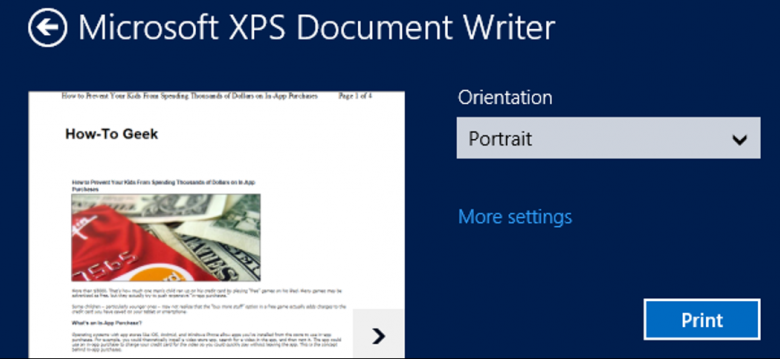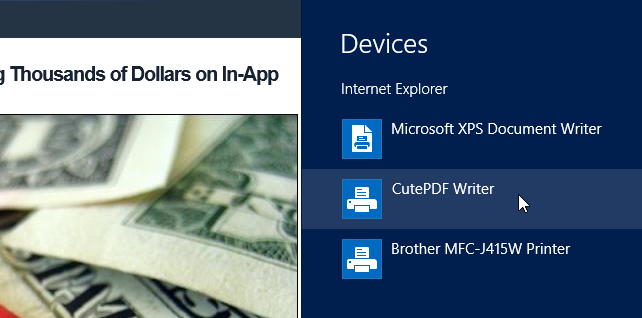
What Is an XPS File and Why Does Windows Want Me to Print to One?
Microsoft’s XPS format is a PDF substitute. It was first launched in Windows Vista, but it never really took off. Modern versions of Windows, on the other hand, continue to support XPS files better than PDF files.
The XPS file format, which was once viewed as a potential “PDF killer,” is still alive and well in Windows, seemingly out of sheer inertia. The average person should avoid XPS files and instead utilize PDF files.
Note: If you’re using Windows 10, you’ll notice that they’ve now included built-in support for printing PDF files, so you won’t have to deal with an XPS file again. Continue reading for posterity’s sake, and instead of XPS, use PDF.
What’s an XPS File?
Consider an XPS file to be similar to a PDF (or PostScript) file. An XPS file, like a PDF file, represents a document with a defined layout. Other capabilities included in PDF, like digital signatures and DRM, are also supported by XPS.
XPS stands for Open XML Paper Specification, and it is currently a standardized, open format. In the same manner that “Office Open XML” is an open, standardized format for Microsoft Office documents, XPS is an open format. Other software vendors have been slow to embrace XPS.
Windows 8 generates XPS files with the OXPS file extension by default. OpenXPS is the standardized version of the original XPS format, and it stands for OpenXPS. Because the XPS Viewer included with Windows 7 isn’t compatible with OXPS files, you’ll have to convert them to XPS to view them on Windows 7.
In a nutshell, an XPS file is a less-compatible variant of a PDF file created by Microsoft.
XPS Functionality Included With Windows
XPS tools are included in Windows Vista, Windows 7, and Windows 8. Files are even better supported by Windows 8 than PDF files.
- Microsoft XPS Document Writer: A virtual printer named “Microsoft XPS Document Writer” is installed by Microsoft. The documents you print to this printer are saved as XPS files. It’s similar to the “print to PDF” option, but it’s less useful because it’s incompatible with other programs.
- XPS Viewer: You may view XPS documents on your desktop using the included XPS Viewer application.
While Windows 8 boasts greater PDF support thanks to the Modern “Reader” program, if you want to read PDF files on the desktop or print to PDF files, you’ll need a third-party app.

When Should You Use XPS Files?
While XPS was viewed as a potential “PDF executioner” when it was incorporated with Windows Vista six years prior, it never turned out to be extremely famous. Despite the fact that Windows pushes its clients into printing XPS records instead of PDF records by including the XPS Document Writer printer, hardly any clients appear to make XPS documents.
It’s hazy for what reason you’d really need to make an XPS record rather than a PDF record, except if you need to print a report to a document and can’t introduce a PDF printer. Microsoft has unquestionably not been presenting a defence for XPS records being superior to PDF documents and has been quiet on any motivation to utilize them as of late. Truth be told, Windows 8’s consideration of a PDF watcher can be viewed as Microsoft making a stride back, presenting support for a contending report design.
While the upsides of printing to XPS records are hazy, the detriments are genuinely clear. The world has to a great extent normalized on PDF documents, while XPS records stay little utilized. In case you’re attempting to send somebody a record, you can wager they’ll be acquainted with PDF documents and will actually want to open it. An XPS record might look new and the beneficiary will be unable to open the document. For instance, Macs do exclude worked in XPS document support, however, they do incorporate implicit PDF support. Numerous different projects might uphold PDF records, however, will not help XPS documents. There are outsider watcher applications that can peruse XPS documents, however, support is not even close to normal.

In synopsis, you presumably don’t have any desire to utilize XPS records for your own reports. XPS appears to be ignored, similar to one more Microsoft innovation presented around a similar time: Silverlight. Silverlight should be Microsoft’s “Streak executioner,” however it’s presently being saved. Similarly, as Silverlight neglected to supplant Flash, XPS can’t supplant PDF.



